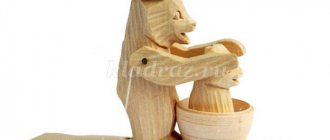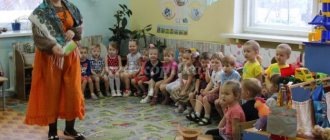Unconventional ways of learning poems
Before learning a poem, you need to do some preliminary work. It involves introducing children to objects and phenomena that correspond to the content of a work of art.
The methodology for memorizing a poem in class includes the following structural components: preparing children to perceive the poem; expressive reading of a poem by a teacher (2 times); conversation on the content of the poem; repeated reading of the poem by the teacher (third time); reading a poem by children.
To facilitate the memorization of poetic works, you can use auxiliary methods, including non-traditional memorization techniques.
1 way.
Method of illustration.
Even K. D. Ushinsky wrote “Teach a child some five words unknown to him - he will suffer for a long time and in vain, but connect twenty such words with pictures, and he will learn them on the fly.”
It has been proven that in preschool age visual-figurative memory predominates and memorization is mainly involuntary. Children's memory has an amazing property - exceptional photographic ability. The visual image preserved in the child after listening, accompanied by viewing the drawings (the action of involuntary attention and involuntary visual memory), allows you to remember the poem much faster.
This method involves establishing a semantic connection between a word or sentence and a picture. The picture helps the child understand the meaning of the poem, remember key rhyming words, keeping the sequence of actions and events.
According to this method - the method of illustrations, the content of one, two or four lines of a poem is indicated by a certain picture that most clearly reflects this description.
For children in the senior group, the selected verses are depicted in 4-5 pictures, for children in the pre-school group – 7-8.
Let’s show this using the example of L. Sorokin’s poem “The clubfooted bear hears...”
Method 2.
Learning poetry in motion.
Using this method, the teacher expressively reads the entire text, and then offers to act it out, depict it in motion. For example, “The sun is shining (we draw a large circle in the air with our hands, and we depict a smile on our face), the leaves are whispering (we put our hand to our ear, as if listening to the whisper), etc. The teacher shows what movements the children will make in response to the words of the text. (You can come up with movements yourself or the children). Children, together with the teacher, pronounce words and perform movements.
Or, in another way, the teacher invites the child to take a large thick thread and “wind a ball out of the poem.” Together with him, rhythmically, we seem to “wind” line by line onto a “reel” in our head. Reeled in? And now we tell it again and unwind it, and then rewind it again. Then we hide the arms together with the ball behind the back and “wind it up for fun.” The main principle here is that we give a kinesthetic child (that is, one who needs not only to look, but also to touch) the support necessary for memorization - we reinforce the memorization with a motor act. As a variation of this method, you can invite your child to place marbles in the dish. Stitch the ball, and then take it out one at a time and put it back in again. Or string beads on a thread.
Summary of a lesson on speech development in the senior group. Reading works of fiction
Topic: Reading works of fiction. “If you love to ride, you also love to carry a sleigh” (based on the works of E. Moshkovskaya “Lezhebok”, N. Nosov “On the Hill”).
Goal : to teach children to feel and understand the nature of the images of works of art, to assimilate the sequence of plot development, to notice expressive and visual means that help reveal the content; teach children to understand the figurative meaning of some phrases and sentences.
Progress of the lesson
The teacher reads E. Moshkovskaya’s poem “Lezheboka” to the children.
- Sloth lives bitterly:
- The couch potato's bed is high,
- The floors are far from the bed,
- Getting off the Sloth is a hassle!
- Here lies Lazyboka,
- Slothless sleeps without a deadline,
I’ve already laid down both sides...
He sleeps and sighs deeply:
- If only there were two more sides!..
- Guys, do you feel sorry for Sloth? (Children's answers).
- What can you advise Slothboy so that his life would not be so bitter and difficult? (Children's answers).
- Guys, do you want your friend to be Slacker? Why? (Children's answers).
- It turns out that no one wants to be friends with Sloth. No wonder they say: “He who is lazy is not valued.”
— Guys, would you like to make friends with Kotka Chizhov from N. Nosov’s story “On the Hill” ?
The guys worked all day: they built a snow slide in the yard. They shoveled snow and dumped it in a heap under the wall of the barn. Only by lunchtime the slide was ready. The guys poured water on her and ran home for dinner.
“Let’s have lunch,” they said, “while the slide freezes.” And after lunch we will come with a sled and go for a ride.
And Kotka Chizhov from apartment six, how cunning! He didn't build the slide. He sits at home and looks out the window as others work.
The guys shout at him to go build the slide, but he just throws up his hands outside the window and shakes his head - as if he’s not allowed to. And when the guys left, he quickly got dressed, put on his skates and ran out into the yard.
Chirk! - skating in the snow. - Chirk! And he doesn’t know how to skate properly. I drove up to the hill.
“Oh,” he says, “it turned out to be a good slide.” I'll jump now.
As soon as I climbed the hill, I hit my nose!
“Wow,” he says, “slippery!”
I got to my feet and again - bang! He fell ten times, but he can’t climb the hill. "What to do?" - thinks. I thought and thought and came up with the idea: “Now I’ll sprinkle sand on it and climb on it.”
He grabbed the plywood and drove to the janitor's room. There's a box of sand. He began to drag sand from the box up the hill. He sprinkles in front of himself, and he climbs higher and higher. I climbed to the very top.
“Now,” he says, “I’ll jump!”
He pushed off with his foot and again - bang with his nose! Skates don't skate on sand! Kotka lies on his stomach and says:
- How can we ride on the sand now?
And he climbed down on all fours.
Then the guys came running. They see: the hill is covered with sand.
- Who messed it up here? - they shouted. - Who sprinkled sand on the hill? Have you seen it, Kotka?
“No,” says Kotka, “I didn’t see it.” I sprinkled it myself because it was slippery and I couldn’t climb on it.
-Oh, you smart guy! Look what you came up with! We worked and worked, and he sand! How to ride now?
- Kotka says:
- “Maybe someday it will snow, it will cover the sand, and then you can ride.”
- “So it might snow in a week, but we need to go skiing today!”
- “Well, I don’t know,” says Kotka.
- Do not you know! You know how to ruin a slide, but you don’t know how to fix it! Grab a shovel now!
- Kotka untied his skates and took a shovel.
- - Cover the sand with snow!
- Kotka began to cover the hill with snow, and the guys poured water on it again.
- “Now,” they say, “it will freeze, and you can ride.”
- And Kotka liked the work so much that he also made steps on the side with a shovel.
“This,” he says, “makes it easy for everyone to climb.” Otherwise someone else will sprinkle sand again.
-Who is the story about? (About the guys, about Kotka Chizhov.)
— What words can you say about the guys who built the slide? What are they? (Friendly, hardworking.)
- What was Kotka Chizhov like at the beginning of the story? (Lazy, cunning, stupid.)
— What was he doing when the guys were building the slide? (He looked out the window, spread his arms, shook his head - as if he couldn’t, he was lazy, didn’t want to work with the guys...)
Card index of fiction in the senior group according to the Federal State Educational Standard with goals
O.O. Contents Author, title Purpose Moral education RNS “The Fox and the Jug” arr.
O. Kapitsa Cultivating good feelings; formation of ideas about greed and stupidity RNS “Winged, hairy and oily” arr. I. Karnaukhova Teach children to understand the character and actions of the heroes of X. Mäkel. "Mr. Au" (chapters), trans. from Finnish E. Uspensky rns "Khavroshechka" arr. A. N. Tolstoy Cultivate manifestations of good feelings towards each other; RNS "Bragging Hare" arr. O. Kapitsa To educate the norms of moral behavior rns “The Frog Princess” arr. M. Bulatov Cultivate kindness and a sense of mutual assistance. B. Shergin “Rhymes” Cultivate a respectful attitude towards other people rns “Sivka-burka” arr. M. Bulatov To develop in children the ability to evaluate the actions of heroes, to express their attitude towards them RNS “Finist-Clear Falcon” arr. A. Platonov Cultivate a sense of compassion for others V. Dragunsky “Childhood Friend”, “Top down, diagonally” Cultivate attentiveness, love, compassion for a close comrade S. Mikhalkov “What do you have?” Nenets fairy tale “Cuckoo” arr. K. Sharov To promote kindness, attentiveness and responsiveness to relatives “Goldilocks”, trans. from Czech K. Paustovsky; cultivate the ability to empathize, be generous, and not envy others; develop self-respect and mutual assistance in work. "Three golden hairs of Grandfather the Omniscient", trans. from Czech N. Arosieva (from the collection of fairy tales by K. Ya. Erben). V. Dmitrieva. “Baby and the Bug” (chapters) Feel and understand the character of the images of L. Tolstoy’s literary work “The Bone” Cultivate the moral qualities of the individual: honesty, truthfulness, love for family. L. Tolstoy “The Jump” To awaken in children empathy for the hero of the story N. Nosov. "Living Hat"; To form children's ideas about moral standards with the help of children's literature. S. Georgiev. “I saved Santa Claus” Develop the ability to evaluate one’s own actions and the actions of heroes, cultivate friendliness, and the ability to interact with peers A. Lindgren. “Carlson, who lives on the roof, has arrived again” (chapters, abbr.), trans. with Swedish L. Lungina K. Paustovsky. “The Thief Cat” To cultivate moral qualities: a sense of compassion, empathy Adam Mitskevich “To Friends” To generalize and expand children’s knowledge about such concepts as “friend”, “friendship”, “honesty”, “justice” P. Bazhov “Silver Hoof” To educate a feeling of kindness, caring for the weak R. Kipling. "Baby Elephant", trans. from English K. Chukovsky, poems in translation. S. Marshak To foster a culture of behavior, friendship, mutual assistance, care for loved ones V. Kataev. “Tsvetik-semitsvetik” To develop the ability to present the characteristics of one’s personality among peers, reflecting achievements and the reasons for possible difficulties.
Self-service, labor RNS "Khavroshechka" arr. A. N. Tolstoy To form children’s ideas about a hardworking person K. Chukovsky “Moidodyr” Education of cultural and hygienic skills K. Chukovsky “Fedorino’s grief” rns “At the command of the pike” To consolidate in children the concept of the importance of human labor A. Barto “The grimy girl” » Cultivate neatness and careful attitude towards personal belongings and belongings of Comrade Yu. Tuvim. “A letter to all children on one very important matter,” trans. from Polish S. Mikhalkova Formation of the foundations of security S. Mikhalkov “Uncle Styopa the policeman” Reinforcing the rules of behavior on the streets of the city E. Segal “Cars on our street” Cognitive development of FEMP Reading books Heroes of fairy tales S. Marshak “Numbers” Acquaintance with numbers Acquaintance with the social world G H. Andersen “Snowman” Introduction to New Year’s traditions of different countries S. Mikhalkov “What do you have?” Introduction to the importance of any profession "Wonderful stories about a hare named Lek", tales of the peoples of West Africa, trans. O. Kustova and V. Andreeva; Acquaintance with the characteristics of the peoples of West Africa A. Gaidar “The Tale of a Military Secret, Malchish-Kibalchish and His Firm Word” Continue to expand children’s ideas about the Russian army. Nenets fairy tale “Cuckoo” arr. K. Sharov Acquaintance with the life of the peoples of the far north M. Boroditskaya “Waiting for a brother” To form a desire to take care of children, to develop a sense of responsibility and respect for younger comrades A. Tvardovsky “The Tankman’s Story” To form in children an idea of the feat of the people who stood up for the defense of their Motherland . A. Barto “The Herd Game” Expand children’s knowledge about their kindergarten, draw attention to its history, clarify ideas about the work of kindergarten employees S. Makhotin “Senior group” O. Vysotskaya “Kindergarten” T. Aleksandrova “Kuzka the Brownie” (chapters) Cultivate interest in the life of Russians in ancient times, love for the history of their people M. Isakovsky “Go beyond the seas and oceans” Clarify knowledge about your native country. B. Almazov. “Gorbushka” Introduction to Russian values; Introduction to the natural world rns “Bragging Hare” arr. O. Kapitsa To form children’s caring attitude towards nature, the desire to take part in its conservation and protection. L. Tolstoy. “Lion and Dog”, “Bone”, “Jump” Expand ideas about the life of animals G. Snegirev “Penguin Beach” K. Paustovsky. “Cat Thief” Foster love and respect for nature, kindness; V. Bianchi “Owl” Continue to form an idea of the interconnection and interdependence of living beings, an idea of the literary genre “educational fairy tale”; B. Zakhoder “Gray Star” To cultivate a sense of empathy and love for nature and man, the ability to resist evil S. Yesenin “Bird cherry” To help feel the beauty of nature in R. Kipling’s poem. "Baby Elephant", trans. from English K. Chukovsky, poems in translation. S. Marshak Develop fine motor skills, attention and interest in the animal world and its diversity



